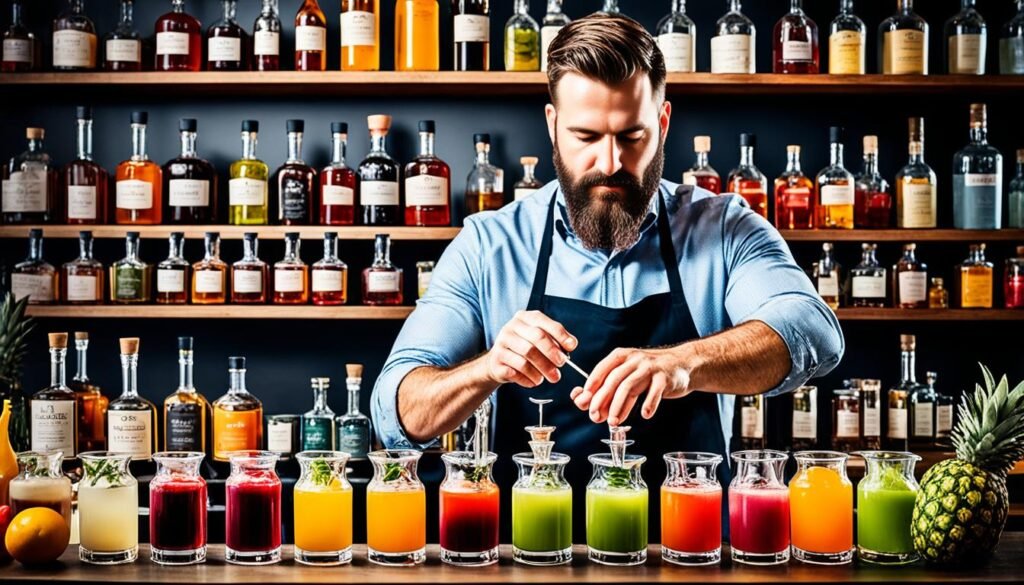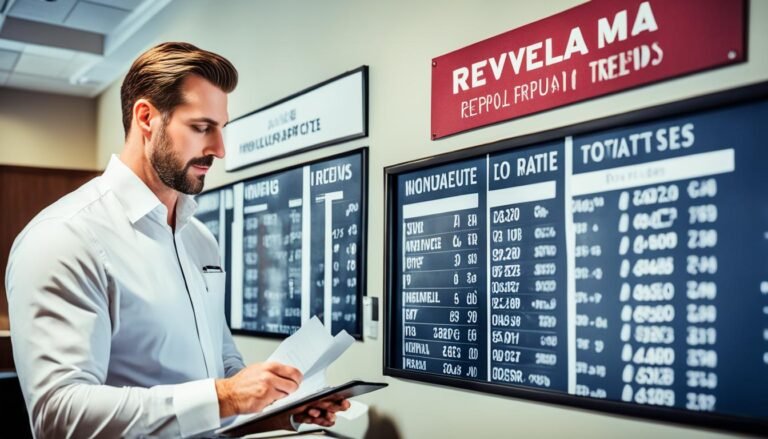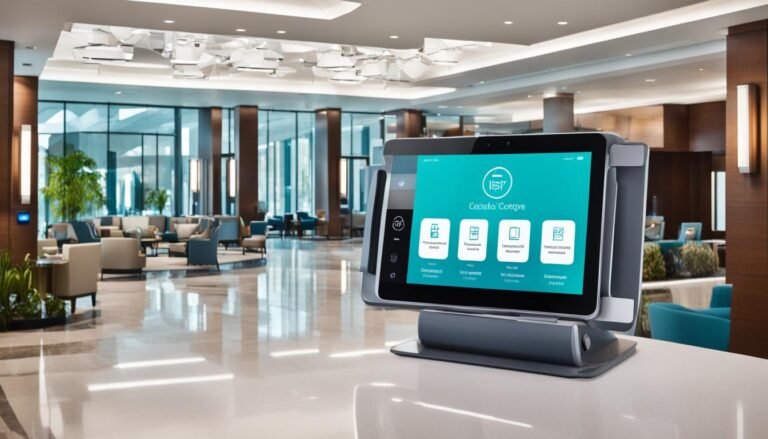Mastering Food and Beverage Management Basics
Success in running a restaurant needs both cooking skills and business know-how. As a food and beverage manager, your job is crucial for the restaurant’s smooth running. You ensure guests enjoy both great food and excellent service. To stand out in this field, you must know the basics of managing food and drink services.
Meet Sarah, who set out to understand the hospitality industry. She loved cooking and understood flavors well. Yet, she realized great management needed more than just a love for food.
Sarah learned about running a restaurant, covering menu planning and customer service. She saw that a successful place needs its kitchen, service, and money matters to work together. This insight prepared her for success in hospitality.
Starting her career, Sarah found out food and beverage management was challenging. It needed strict organization, clear communication, and the ability to solve problems fast. Sarah met these difficulties with a can-do attitude, always aiming to get better.
By never stopping her learning, Sarah became skilled at managing food and drinks. She ran the kitchen smoothly, ensuring food looked great and tasted even better. Her attention to detail made each serving a delight for guests.
Today, Sarah is an admired leader in hospitality, thanks to her management skills. Her talent in providing great dining experiences and leading a team has made her a professional in the industry.
Want to be like Sarah and learn the essentials of food and beverage management? Come with us as we explore the key points and strategies. Let’s discover what it takes to succeed in this dynamic area.
Key Takeaways:
- Running food and beverage places needs both cooking knowledge and business leadership.
- It’s vital to know how to plan menus, save money, and offer great service for success.
- Seeing small details and being flexible are crucial in this management role.
- Learning always and being dedicated are the secrets to excelling in food and drink management.
- Turning meals into unforgettable moments, leading a team well, and surpassing customer needs define a great manager.
Understanding Beverage Basics and Regions
To be great in serving drinks, you need to understand the basics. You should know about all kinds of drinks and what makes each special. Learning about where popular drinks come from helps you suggest the perfect one to guests.
The Diversity of Beverage Basics
There are so many drink options out there. From simple juices to the rich tastes of wines and spirits, each has its own story. Knowing what fruity cocktails or hoppy beers taste like lets you recommend the best to your guests.
Discovering Beverage Regions
The drink world is like a map of flavors from different places. Every region has its own way of making drinks, creating unique tastes. Places like Napa Valley are famous for wines that go great with certain foods. Knowing about these regions helps you show guests new and tasty drinks.
Unveiling Flavor Profiles
Understanding flavor is key to matching drinks with food. Bold red wines go well with hearty meals, while whites can make light dishes shine. By knowing what each drink tastes like, you can help guests find the perfect pairing.
| Beverage | Distinctive Characteristics |
|---|---|
| Wine | Varies based on grape variety, region, and winemaking techniques. Can be light and crisp, bold and fruity, or rich and full-bodied. |
| Spirits | Range from clear and unaged (like vodka) to richly colored and aged (like whiskies). Each has its unique flavor profile, influenced by ingredients, distillation processes, and aging methods. |
| Beer | Diverse categories, including lagers, ales, stouts, and IPAs, each with distinct flavors resulting from the combination of hops, grains, yeast, and brewing techniques. |
| Non-Alcoholic Beverages | Offer a wide range, including fruit juices, sodas, flavored waters, and specialty mocktails, with each providing different sweetness levels, flavors, and refreshment. |
Assisting Guests with Beverage Selections and Pairings
Waiters have a big role in helping guests pick the right drinks. They ask about the guest’s likes to learn what they might enjoy. This helps the waiter give good advice, especially based on the food’s flavor.
It’s key to know what the customer will probably enjoy. Some like strong tastes, while others like softer ones. Helping them find the best match makes their meal more enjoyable.
For the best dining experience, the drink and food flavors should match well. A great pairing can make everything taste even better. Think about the dish’s main flavors, like sweet or spicy, when suggesting a drink.
For a steak, a rich red wine might be perfect. But for a seafood salad, a white wine or light beer works better. This way, the drink makes the food taste even more delicious.
“By understanding their unique preferences, you can guide them towards beverage selections that align with their taste profiles.”
It’s important to think about what your guests like and need. Some don’t drink alcohol or might have allergies. Make sure you have plenty of options, from fun non-alcoholic drinks to teas and a bit of alcohol.
Top Tips for Assisting Guests with Beverage Selections and Pairings:
- Engage guests in conversation to understand their preferences and taste profiles.
- Consider the taste elements of the dishes they have chosen when making recommendations.
- Suggest beverage pairings that enhance the flavors of the food.
- Offer a diverse range of options, including non-alcoholic alternatives.
| Beverage Selection | Taste Profile | Food Pairing |
|---|---|---|
| Chardonnay | Medium to full-bodied with flavors of ripe fruits and buttery notes. | Pair with seafood, white meats, or creamy pasta dishes. |
| IPA | Bold and hoppy with a strong bitter taste. | Complement spicy or grilled foods. |
| Moscow Mule | Refreshing with a balance of spicy ginger and tangy lime. | Pair with Asian or Mexican cuisine. |
Mastering Beverage Presentation and Service Techniques
Beverage presentation and service are key for a memorable dining time. How a drink looks and is served can make it more enjoyable. So, details matter a lot in serving drinks.
To make a drink look good, add garnishes like fruits or herbs. Choose the right glassware to make the drink shine a little more.
Service is also important for a smooth experience for everyone. Learn how to pour different drinks correctly. This includes wine, beer, and liquor. Study the best ways to pour each to show your skills.
Good posture and speed show you are a pro. Keep your back straight and move smoothly while working. This approach makes your guests see you as confident and skilled.
Benefits of Mastering Beverage Presentation and Service Techniques
- Enhances the overall dining experience
- Creates a visually appealing presentation
- Increases guest satisfaction and likelihood of return visits
- Highlights your expertise and attention to detail
- Elevates the perception of the establishment
Mastering drink serving isn’t just about handing out drinks. It’s about making a real difference. It helps you stand out and be remembered for great service.
Knowledge of Beverage Offerings
Wine is key, but knowing all drinks is crucial. Learn the whole drinks menu, from cocktails to non-alcoholic choices.
Getting into mixology and new drink trends can make your tips and descriptions better. This makes eating out better for everyone.
Menu Highlights
| Beverage Category | Examples |
|---|---|
| Cocktails | Margarita, Old Fashioned, Mojito |
| Spirits | Whiskey, Vodka, Rum |
| Beers | IPA, Stout, Wheat |
| Non-Alcoholic | Fruit Mocktails, House-Made Sodas |
Knowing the menu well helps you recommend drinks that fit each person’s taste. This makes their meal more enjoyable.
“Crafting a memorable beverage experience requires staying updated on industry trends and continuously exploring the world of mixology.”
Being a drink expert lets you help guests find what they’ll love. You can point out what’s special about each drink.
Proper Handling and Storage of Beverages
It’s key to keep beverages fresh for a great dining experience. Proper storage helps keep flavors and quality intact.
Being aware of the right temperatures for drinks is crucial. Wine stays best between 50°F and 60°F to save its taste. Beer, however, does well in colder settings, like 38°F.
Some drinks need special care when storing. Spirits should stand up to keep the cork from drying out and the drink from going bad. Also, certain wines should lie flat to help the cork stay moist and seal correctly.
Serving drinks well is important for the guests’ enjoyment and safety. It’s vital to follow rules for serving alcohol correctly. This means not overdoing it and watching how much your guests drink.
It’s also crucial to keep the places where you store or serve drinks clean. Always organize and clean the fridge and bar. Make sure to use older drinks before new ones. Clean everything often to stop bugs or dirt from ruining the drinks.
Tips for Proper Beverage Handling and Storage:
- Store wine between 50°F and 60°F to preserve its flavors.
- Beer should be stored at colder temperatures, typically around 38°F.
- Keep spirits upright to minimize cork contact and prevent oxidation.
- Store delicate wines horizontally to keep the cork moist and maintain a proper seal.
- Adhere to guidelines for responsible alcohol service, serving in moderation.
- Regularly clean and organize refrigerators and bar areas to ensure freshness.
“By implementing proper handling and storage techniques, you can provide guests with the best possible beverage experience. Keeping beverages at their optimal conditions and serving responsibly demonstrates your dedication to their enjoyment and well-being.”
| Beverage | Optimal Storage Temperature | Storage Method |
|---|---|---|
| Wine | 50°F to 60°F | Store bottle horizontally |
| Beer | 38°F | Keep in refrigerator |
| Spirits | Room temperature | Store upright |
Educating Yourself and Continuing Your Beverage Journey

The beverage world is always evolving. To be a top player in the field and offer great service, you must always learn and grow. By getting more knowledge and honing your skills, you make your guests’ experiences unforgettable.
Continuous learning is essential for keeping current with trends. Go to tastings, seminars, and workshops to learn about various drinks. You’ll meet pros and learn about new things in the industry.
Exploring Industry Developments
Knowing the latest in the industry sets you apart. Read industry news, sign up for newsletters, and engage in online discussions to stay informed. This insight helps you improve the drinks you serve.
Mixology advancements show how mixologists are ever-creative. Know about classic cocktails but also try new recipes. This way, you’ll make drinks that people will remember.
Keep learning to lead in the beverage field. Be open to new trends, attend functions, and learn more to give great service and memorable experiences.
Image: Mixologist Crafting a Signature Cocktail
Traditional ways of learning are not the only option. Use tech for webinars, podcasts, and videos. These are easy ways to learn from the best in your own time.
Continuing the Beverage Journey
Learning about drinks is a journey with no end. Always try new flavors and combinations. Stay curious as you grow your knowledge and skills.
Overview of Food and Beverage Management
Food and Beverage Management (F&B management) is crucial for a successful establishment in the hospitality industry. It involves planning, organizing, directing, and controlling food and beverage operations. These operations happen in a restaurant or hotel. F&B management covers kitchen management, creating menus, serving customers, and keeping an eye on the money.
F&B managers lead the kitchen, making sure food is cooked properly and on time. Their job is to keep the food safe, maintain hygiene, and ensure quality. They also handle ordering supplies so the kitchen doesn’t run out. Plus, they try to prevent waste and save money.
Creating the right menus is essential for F&B managers. They work with chefs to make menus that meet what the customers want and what’s trendy. They think about what ingredients are in season, different diets, and what customers like. A good menu makes eating out more enjoyable, brings in more people, and helps the business earn more.
“F&B management involves overseeing kitchen operations, menu development, customer service, and financial performance.”
Looking after customers is key in F&B management. Managers make sure customers have a good time from the moment they walk in. They teach the staff how to be great at their jobs. They also handle any complaints quickly to keep customers happy.
Keeping the business strong financially is a big part of the job for F&B managers. They watch sales, spending, and how much money the place makes. By looking at the money closely, they find ways to save and make more money. This strong financial control is what keeps the business growing and successful.
Kitchen Operations
This table gives you an overview of kitchen operations in F&B management.
| Aspect | Description |
|---|---|
| Food Preparation | Ensure meals are made on time and meet quality and safety rules. |
| Inventory Management | Control the ingredients and supplies to save money and avoid shortages. |
| Hygiene and Safety | Maintain a clean and safe kitchen by following hygiene and safety rules. |
| Staff Training and Supervision |
Menu Development
The next table shows what F&B managers think about when designing menus.
| Consideration | Description |
|---|---|
| Target Market | Learn what the customers like and need to make menus that fit. |
| Seasonality | Update menus based on what foods are in season and add special dishes. |
| Trends | Keep menus interesting with new trends and popular dishes. |
| Dietary Preferences | Offer options for different diets like vegetarian or gluten-free. |
Managing a food and beverage place takes understanding of many areas. This includes the kitchen, what goes on the menu, how customers are treated, and managing money. Doing well in these areas makes the business run smoothly and keeps customers happy.
Responsibilities of a Food and Beverage Manager
A food and beverage manager has many roles in making a restaurant or hotel succeed. They plan menus, manage the kitchen, control costs, and handle customer service and staff. This involves making sure everything from the food to the service is excellent.
Menu Planning and Design: Your main job is to create menus that people love. You mix seasonal foods, the latest food trends, and special diets to make dishes people will enjoy. This is how you keep people coming back.
Kitchen Management: Making sure the kitchen runs smoothly is key. You set rules that everyone follows to keep things clean and safe. This makes the food taste great and keeps customers happy.
Cost Control: Keeping how much you spend in check is very important. You watch over what you buy and figure out ways to save money. Doing this well can make the restaurant more successful.
Customer Service: You lead a team in making customers happy. This means making sure orders are right, dealing with complaints, and making the place welcoming. Great service keeps people coming back.
Staff Management: Leading your team is a big part of your job. You hire and train new people, and make sure they’re doing their best. This helps the restaurant work like a well-oiled machine.
Doing these tasks well makes a huge difference in a restaurant’s or hotel’s success. Your hard work in planning, managing, and leading leads to happy diners and a healthy business.
Conclusion
Getting the basics of Food and Beverage Management right is key to making it big in the hospitality world. You need to know your drinks well and keep learning to give the best service. Helping guests choose, showcasing your drinks well, and keeping up with what’s new all improve the eating and drinking experience.
Handling food and drinks is a big job with many parts, like making menus, running the kitchen, managing costs, and leading a team. If you learn these key parts well, you can make your guests’ dining experience great and memorable.
It doesn’t matter if you’re new to the game or have been around; a strong grasp of Food and Beverage Management is crucial. Keep improving your skills, stay on top of latest trends, and aim to offer top-notch service. This way, you will make every guests’ visit better and help your business do well.







